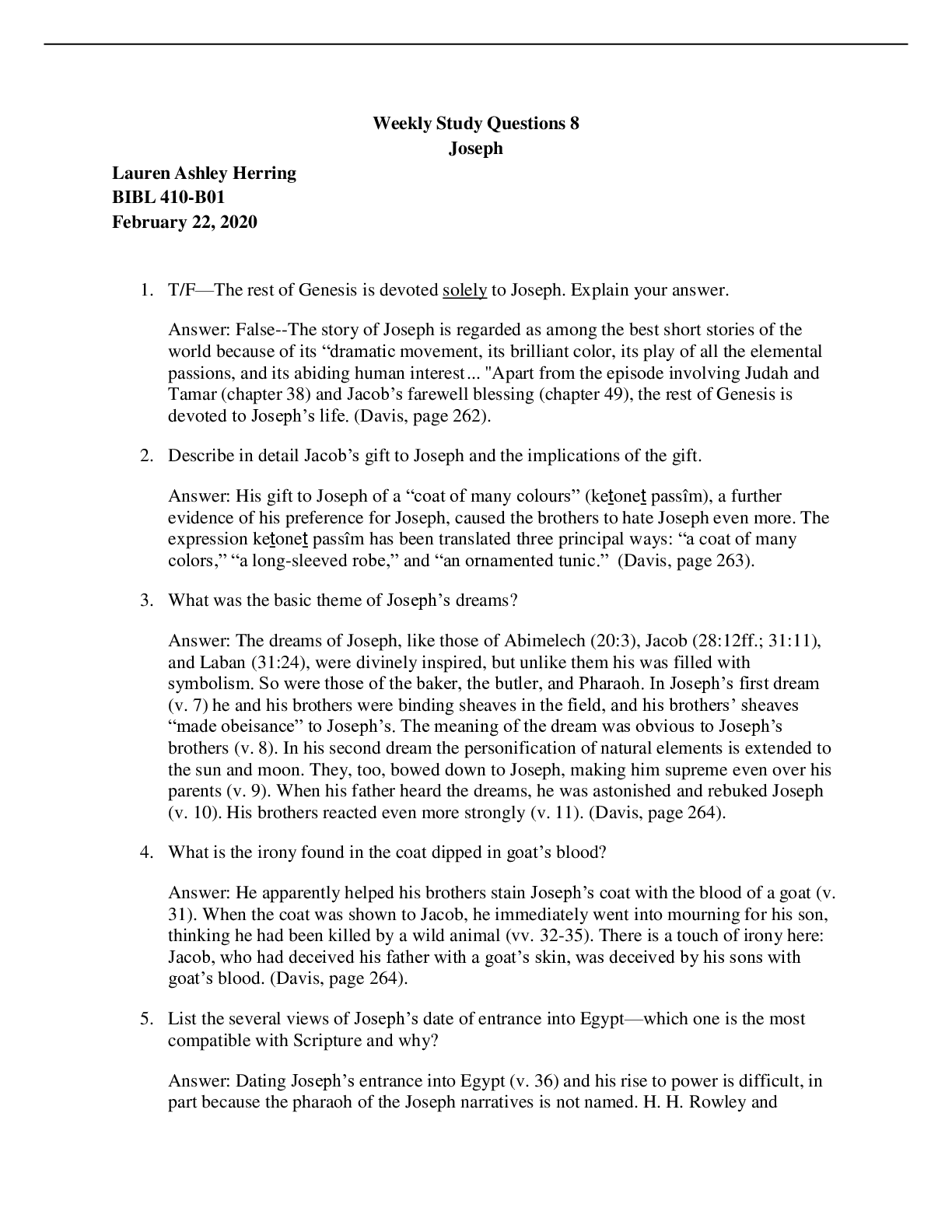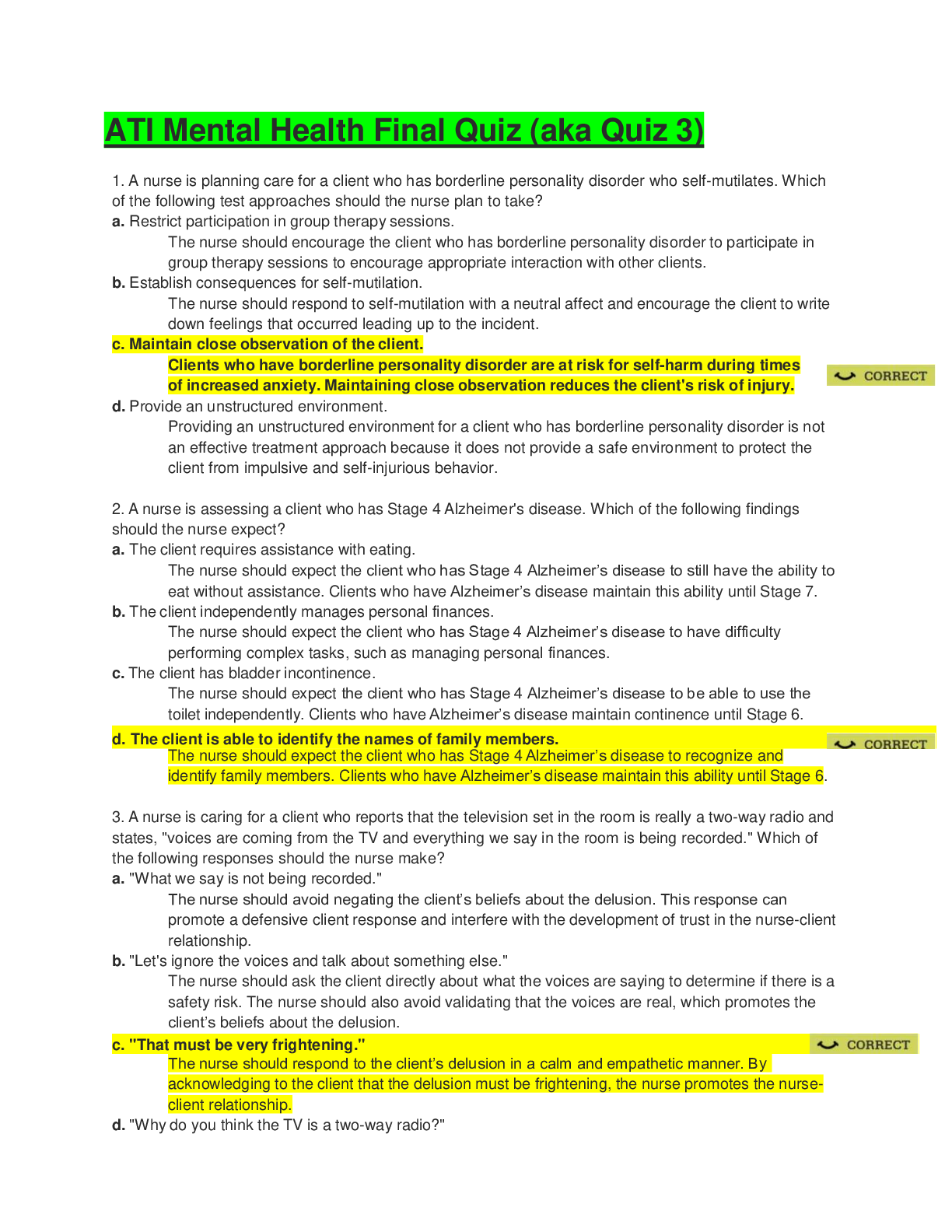Biology > QUESTIONS & ANSWERS > A 29-year-old man was referred to physical therapy because of a cervical strain injury that happened (All)
A 29-year-old man was referred to physical therapy because of a cervical strain injury that happened during a recent motor vehicle accident
Document Content and Description Below
1. Question 1 Use the following case to answer questions 1-7 Case 5 A 29-year-old man was referred to physical therapy because of a cervical strain injury that happened during a recent mot... or vehicle accident. The man was attempting to enter traffic from a street-side parking place where he had parallel parked; he admits that he failed to accurately judge the flow of traffic into which he was entering. In the course of your physical examination of this individual, you decide to perform some simple visual field testing and discover that the man cannot see much of anything to the left of midline with either eye. How would you BEST describe this patient's visual field deficit? 1 point right eye blindness bitemporal or heteronymous hemianopsia right homonymous hemianopsia left homonymous hemianopsia left eye blindness 2. Question 2 What visual problem can you RULE OUT, given what you know so far about this patient? (Select all that apply.) 1 point a possible lesion involving the right posterior-lateral thalamus a possible lesion involving the left cuneus and lingual gyri optic neuritis in the left optic nerve, often an early indication of multiple sclerosis a possible lesion in the left optic tract a possible lesion in the optic radiations very close to the lateral geniculate nucleus a possible lesion involving the left posterior-lateral thalamus a possible lesion in the right optic tract a possible lesion involving the right cuneus and lingual gyri 3. Question 3 Upon further discussion with the patient, you learn that he has a significant medical history. About 5 or 6 years ago, the patient began having complex partial seizures, meaning that he had seizures that began in one location in the brain with an accompanying temporary loss of consciousness. One year ago an MRI revealed a left temporal lobe tumor and he underwent tumor resection. Upon resection, the tumor was found to be a pilocytic astrocytoma, and he was treated with chemotherapy and radiation therapy with an initially good response. Seizures are characterized by a massive barrage of action potentials that can increase and even synchronize the firing of large networks of neurons in the brain. Which of the following conditions might promote the onset of a seizure? 1 point enhanced function of glutamate reuptake systems in astrocytes and presynaptic terminals elevated levels of GABA in the extracellular fluids in and around synaptic junctions insertion of new GABA-A receptor channels in the postsynaptic membranes elevated levels of glutamate in the extracellular fluids in and around synaptic junctions endocytosis (internalization) of postsynaptic AMPA receptors cleavage of SNARE complexes in presynaptic terminals of excitatory synapses 4. Question 4 Below is a recent T1-weighted MRI of this patient in the axial plane at the level of the midbrain showing the resected region in the anterior left temporal lobe. (This is an MRI so the left side of the patient is seen in the right side of the image.) What prominent structure in the left anterior temporal lobe was mostly removed surgically? 1 point insula basal forebrain nuclei hypothalamus Wernicke's area amygdala Broca's area fornix pineal gland 5. Question 5 Knowing that there is damage to the left anterior temporal lobe (especially if the patient is strongly dominant in the left hemisphere), you consider a possible impairment in what aspects of cognition? 1 point spatial awareness working explicit memory emotional processing and learning, especially with respect to fear and social discriminations attention to the left side of the body and the left side of surrounding space procedural (motor) memory producing language 6. Question 6 Upon careful examination of the MRI study, you also suspect that this patient may have a partial right, superior quandrantanopsia because you recognize that the surgical procedure also likely damaged a portion of what structure? 1 point left parietal optic radiation left Meyer's loop left optic tract left optic nerve left cuneus gyrus optic chiasm left lingual gyrus 7. Question 7 In the same MRI study but at a slightly more superior level, gadolinium enhancement shows that MR signal is abnormally high in the right optic tract and in the region of the right lateral geniculate nucleus. (Gadolinium enhances contrast in tissue where there is a breakdown of the blood-brain barrier, suggesting an ongoing pathological process.) This MRI evidence strongly suggests which of the following pathological processes as the explanation for the visual field deficit in this patient? 1 point hydrocephalus superior to the cerebral aqueduct Parkinson's disease amyotrophic lateral sclerosis meningitis diabetic neuropathy affecting the retinas of both eyes recurrence of the astrocytoma in the right, lateral diencephalic region 8. Question 8 Use the following case to answer questions 8-11 Case 6 A newborn infant presents in the neonatal intensive care unit with an obvious lesion protruding from the surface of the lumbar region of the back. Without even seeing this infant, which of the following should be at the top of your list of possible lesions? 1 point medulloblastoma, which is a primary brain tumor originating in the posterior cranial fossa that is relatively common in children a skin lesion consistent with shingles a neural tube defect called anencephaly a neural tube defect called spina bifida a skin lesion consistent with melanoma 9. Question 9 Which of the following developmental events most likely failed in this infant? 1 point gastrulation complete closure of the caudal neural tube notochord formation complete closure of the rostral neural tube neurotrophin signaling between muscle and nerve neural crest migration programmed cell death of excess spinal motor neurons 10. Question 10 This child is expected to have severe impairments of somatic sensation and motor control involving body regions that are supplied by spinal cord segments at and below the level of the lesion. Consider the impact of abnormal somatic sensory and motor experience in this infant, even if the brain formed normally in utero. What is the impact of abnormal sensorimotor experience on the construction of neural circuits in the cerebral cortex in early postnatal life? 1 point Abnormal experience will promote long-term depression only if there is a cessation of presynaptic activity and synaptic connections go silent (thus, "use it or lose it"). Abnormal experience will prevent this child from gaining the small benefit of experience-dependent development, but only after genetic instructions have played out and self-organization has run its course in the construction of functional neural circuits. Abnormal experience has no impact on the construction of neural circuits, only the fine tuning of fully functional circuits in later childhood. Abnormal experience in early critical periods may lead to lasting functional impairment, if abnormal experience engenders "uncoordinated activity" in functional circuits leading to the weakening of their synaptic connections. Abnormal experience will promote long-term depression of synaptic function if presynaptic activity comes just before (<20 msec) postsynaptic activity. 11. Question 11 Despite the presence of abnormal sensorimotor experience in this infant because of its congenital malformation, appropriate physical interventions may promote the acquisition of functional behaviors. At the level of neural circuits and systems, such physical interventions are promoting all of the following activities (we hope!), EXCEPT for which one? 1 point experience-dependent increases in programmed cell death (apoptosis) and excitotoxicity in functional neural circuits growth and development of functional neural circuits due to the structured intervention engendering synergy between self-organization and experience-dependent mechanisms of circuit construction growth and development of functional neural circuits due to the structured intervention engendering coordinated patterns of presynaptic and postsynaptic activity growth and development of functional neural circuits due to the structured intervention engendering increased production of neurotrophin molecules growth and development of functional neural circuits due to the structured intervention engendering the "awakening" of silent synapses in functional neural circuits 截屏2021-08-24 下午9.32.17.png [Show More]
Last updated: 2 years ago
Preview 1 out of 9 pages

Buy this document to get the full access instantly
Instant Download Access after purchase
Buy NowInstant download
We Accept:

Reviews( 0 )
$12.00
Can't find what you want? Try our AI powered Search
Document information
Connected school, study & course
About the document
Uploaded On
Sep 20, 2021
Number of pages
9
Written in
Additional information
This document has been written for:
Uploaded
Sep 20, 2021
Downloads
0
Views
178














